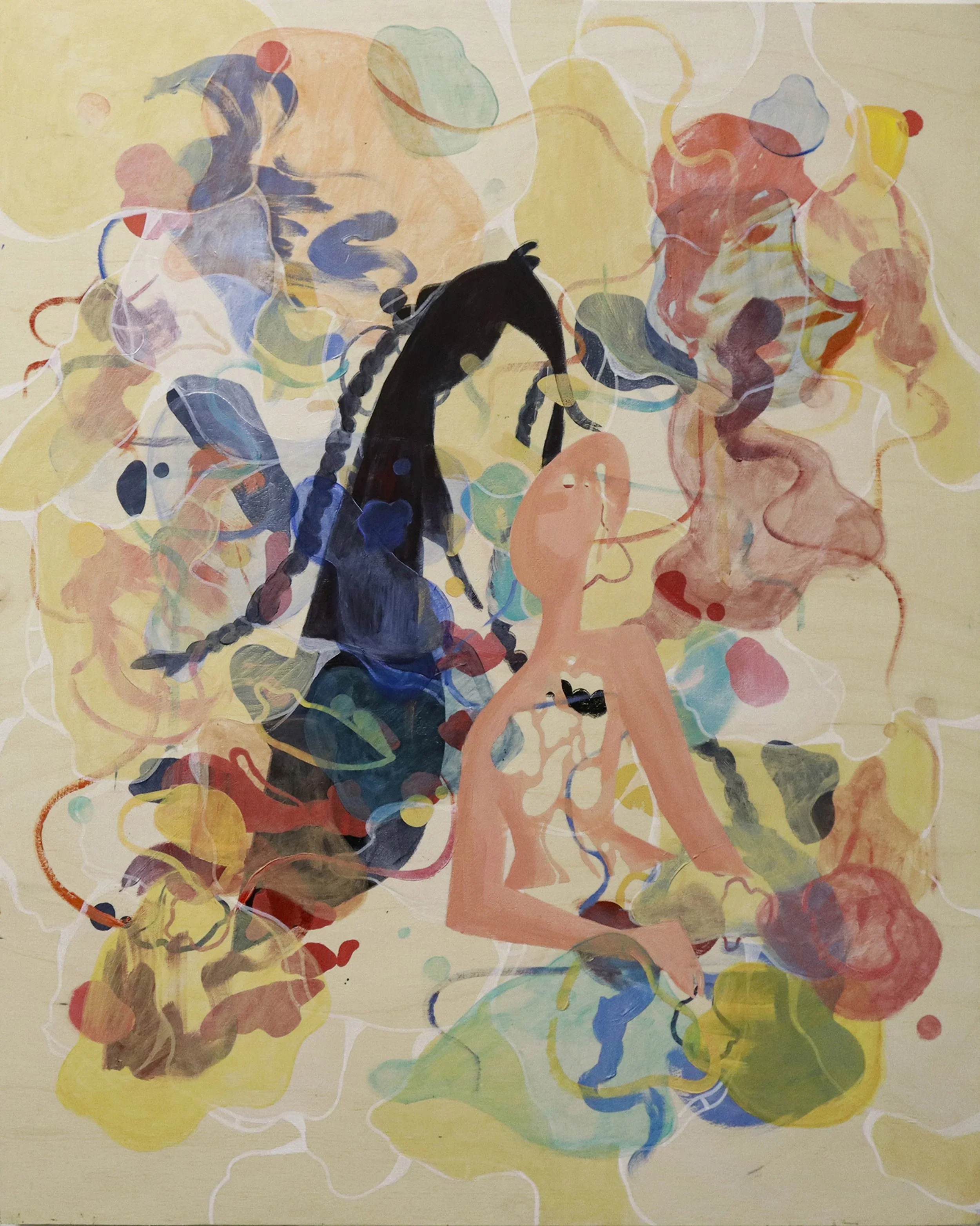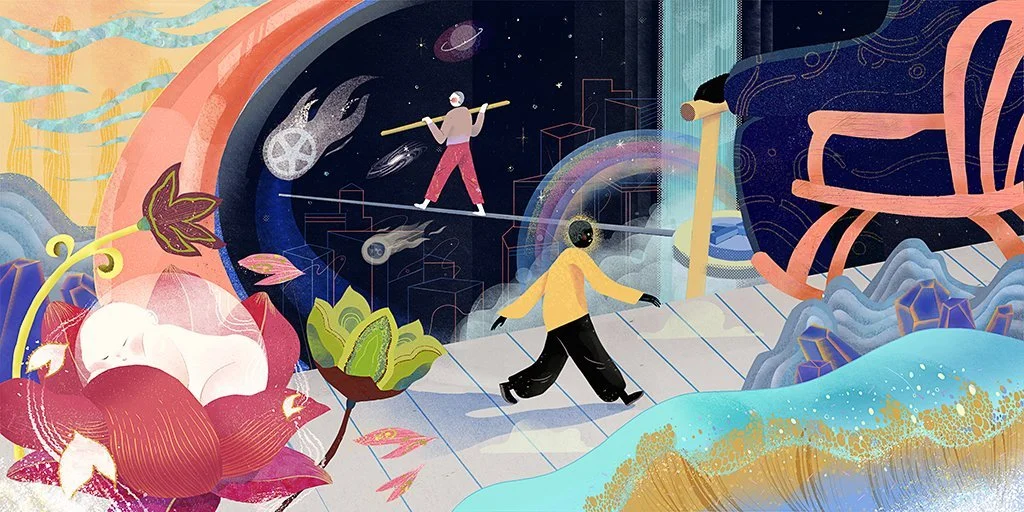10 Questions with Bingjie BJ Cui
Bingjie BJ Cui - Portrait
Bingjie B.J. Cui is a multidisciplinary artist whose work reveals the whimsical and ethnic beauties behind our visual world. With an academic background spanning environmental science, urban planning and design, and illustration, she is passionate about interweaving science fiction, poetry, and art to create an inspiring and vibrant visual experience.
Born and raised in Xinjiang, China, a city known for its cultural diversity, Bingjie “BJ” Cui is heavily influenced by ethnic aesthetics and the local spirit. The interesting jump between her ‘rational’ background in science and ‘emotional’ thinking in art allows her to create artwork that corresponds to literacy and texts.
She creates most of her work digitally, taking inspiration from daily life, social phenomena, and literature. Bold colors, whimsical, surreal elements, and visual puns reveal her passion for visual communication through powerful images.
INTERVIEW
Please let’s talk a bit about yourself. Who are you, and how did you get interested in art?
Born and raised in Xinjiang, China, I’ve been surrounded by ethnic aesthetics. The designated fabric associated with unique and intricate patterns is rooted in my mind. Rich colors, cultural symbolism, and the story behind them trigger my interest in visual communication. I was a science student until my graduate years, though my initial passion for art can be traced back to my life at an early age, living in Urumqi surrounded by ethnic culture.
Mind Flow, Digital, 302x106 mm, 2024 © Bingjie BJ Cui
Your academic background spans environmental science, urban planning and design, and illustration. How do these diverse fields influence and shape your artistic vision and the themes you explore in your work?
This is an interesting one. During my early journey to illustration, I found it challenging to balance the ‘rational’ and ‘emotional’ backgrounds. I need to find a unique voice and think about the way to extract the cores and present them. My science background trained me to think rationally while I can also ‘touch’ my emotional thoughts on the same subject. Then I started to explore ‘deconstruction’, a way to deconstruct flash thoughts and present them sensually. Over time, my passion for art, combined with my science background, led to the exploration beyond the boundary of science and art. My studies of urban planning also inform my creation in art. There’s a vital element we need to consider while developing the concept of urban design- stakeholders and citizens. This, to some extent, potentially expanded my vision of art creation from personal expression to a broader audience. I want my art to be like a language, speaking for the diversity of people, the spiritual expression of our society, and the ancient stories behind our cultures.
Apart from your studies, what experiences or influences helped you develop into the artist you are today?
I believe my childhood and life in Xinjiang are significant parts of where I am now. As mentioned above about the ethnic fabric in my hometown, I was inspired by local culture and spirit at an early age. They are more like roots in my mind, they led to the later vibrant colors and whimsical elements shown in my drawings. Movies and literacy are other influences that have profoundly contributed to my development as an artist. I love chatting with families and friends. Listening to their stories is also a very moving experience for me. Life, cultural integration, and social thinking are subjects that interweave the stories behind my creation.
Diversity Flow, Digital, 6x9 in, 2022 © Bingjie BJ Cui
In Paradise, Digital, 6x9 in, 2022 © Bingjie BJ Cui
As you mentioned in your biography, growing up in Xinjiang, China, helped you familiarize yourself with several ethnic aesthetics and influences. How does this cultural background manifest in your art, and how do you incorporate elements of cultural diversity into your creations?
There are tons of ethnic features in my hometown, while in the first stage, I didn’t use them deliberately in my drawing. When I was in the urban planning program, we shared a lot about the lands in different countries. As the largest province-level division with inclusive ethnic culture in China, I realized my peers knew little about Xinjiang. That was the moment I thought about promoting the reputation and cultural diversity in the land.
Then, over time, I gradually started my art journey. I centered on the subject of cultural integration in my graduate thesis, with a spot on cultural stereotypes in the early editorial market. Beyond the topics, ever since I got ideas and drew them down on paper, I realized I potentially tend to choose colors and techniques that are similar to the traditional designated textiles. The appeal of vintage colors may have been built at an early age and profoundly influenced the perception of rendering in my art.
I love the diversity of our world and how it’s shaped by diverse groups of people. Thus, with the combination of my background and experiences, cultural diversity has inspired me to branch out and influenced my preference in the art creation.
The interweaving of science fiction, poetry, and art is a unique aspect of your creative process. How do you combine these elements to create an inspiring and vibrant visual experience for your audience?
Science fiction and poetry provided me with a wonderland in that I could capture whimsical ideas and flash thoughts beyond reality. They contribute to the liberation of the mind and inspire me to branch out with artistic expression. I use deconstruction and reconstruction. Poetry conveys spiritual feelings while also inspiring people’s moods. I’m driven by some subconscious way of placing and constructing them to create a new work. They shape my way of collecting the flash thoughts and composing them in a fresh visual experience.
Behind the Mountains, Digital, 6x9 in, 2022 © Bingjie BJ Cui
You have a recognizable style, with “bold colors and whimsical, surreal elements,” as you mention. Can you share more about your creative process and how you choose the elements to incorporate into your work?
When I have a subject ready, I often start with brainstorming and thumbnails- a way of capturing flash thoughts and drawing them randomly down on paper. My thumbnail process usually contains elements and a designed composition. I tend to draw elements spiritually connected to the subject. I keep a sketchbook to collect some daily thoughts and inspirations from nature and life, people, and feelings. It’s like a drawing journal recording moments. This is a crucial one to my artistic creation. It’s more like where the miracle happens.
After the thumbnails, I would select two or three compositions, moving to the linework process. Sometimes, during the linework section, I would adjust the composition and elements freely with the subject and visions. Developing color comps is another important way for me to see the final vision, which also allows me to play around with my palette. In rendering, as the last step of the process, I tend to focus more on the details and textural layout. I love the way elements are harmoniously presented with the textural top layer. It adds an interesting final touch to look at the finished pieces.
You work primarily with digital art, but you also mention taking inspiration from daily life, social phenomena, and literature. How do you mix these different sources of inspiration? And how do you work on them digitally?
I believe art originated from life and beyond life. Social phenomena are the reflection of our society, from which we see the identities, the cultural features, the inclusion, and the contradiction. Literature captures the emotional meaning behind our lives for people to speak, enlighten, and inspire the interaction. They are an extraordinary exploration of nature and human beings. Thus, I tend to extract the related meanings behind and mix them to create a fresh angle.
Collecting messages with visual language would be a start. Drawing down pieces of immediate thoughts in a sketchbook does help my creation. At the moment, I feel free to concentrate on the feeling of ‘touching’ these ideas without worrying much about the tech and shapes. To convey a specific subject, I often start with such a thumbnail stage on paper and experiment to find a way of mixing them in effective visual communication with digital tools.
Lotus Buddha, Digital, 6x9 in, 2023 © Bingjie BJ Cui
Ultimately, what messages would you like to convey with your work?
During the early stage of my art journey, my initial intent was to promote the diversity of our society. In the long run, after research and observation of diversity, I took the appreciation of stories behind different nationalities, the fairy tales of ethnic groups, and the intriguing environments of and beyond our universe. I want to celebrate the organic roots of different nationalities, the extraordinary behind our life moments, and mind liberation through thought-provoking art. A deep emotional connection with the audience is my goal.
Is there any other medium or technique you would like to experiment with?
I’m exploring more possibilities of mixed-use techniques. I’m very interested in collages, from which I see how my ideas are visually developed through the creation process. I’m thinking about having some collages ready as the textures to incorporate into my later artwork. Additionally, oil painting and acrylic are two other mediums I like to experiment with. I admire the natural textures created by traditional materials and am always excited to see unexpected textures happen.
Juicy Joy, Digital, 6x9 in, 2022 © Bingjie BJ Cui
And lastly, what are your plans for 2024? Do you have any new exhibitions or projects you want to share with our readers?
As I commence my art journey as a freelance illustrator, my first goal at the moment is to expand the visibility of my work, get more commissions, and build myself as a recognized illustrator in the creative market.
In addition, I’m feeling increasingly drawn to fairy tale subjects and horror stories. I’m looking for opportunities to collaborate with authors on science fiction and explore the possibilities of working on folk mythology and fanciful tales. In the meantime, I’m working on two personal projects at the same time. I’m expanding my ‘In Xinjiang’ series with some new pieces talking about minority ethnic cultures.
I would also like to play around with how to incorporate my background in science, nature, and urban organically into my artwork. Science art is a new field that interests me.
Artist’s Talk
Al-Tiba9 Interviews is a promotional platform for artists to articulate their vision and engage them with our diverse readership through a published art dialogue. The artists are interviewed by Mohamed Benhadj, the founder & curator of Al-Tiba9, to highlight their artistic careers and introduce them to the international contemporary art scene across our vast network of museums, galleries, art professionals, art dealers, collectors, and art lovers across the globe.




















